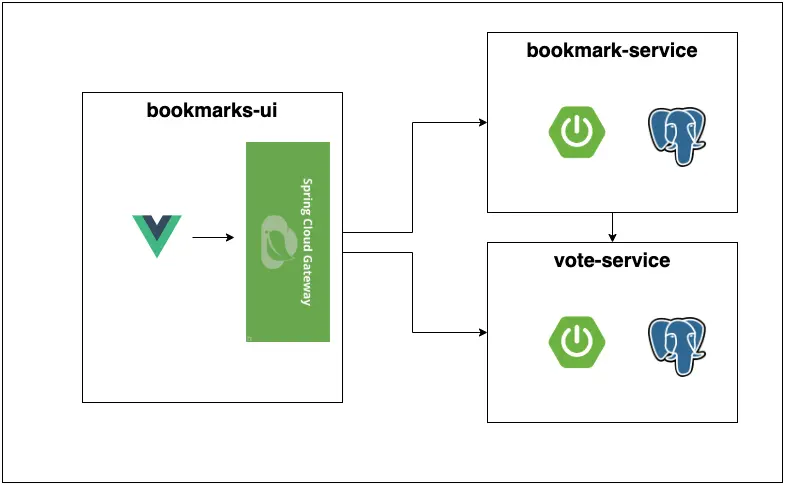SpringBoot Application deployment and monitoring series
Few years ago I wrote a series of blog posts on Developing a simple e-commerce application from scratch to production using SpringBoot. Well, I covered most of the development stuff but left “to production” part because other things came up. Many things changed since then.
Now I want to write a series of articles focusing on deployment and monitoring. So, I am planning to build a simple application using SpringBoot and deploy it in different ways. Along the way I want to learn the things such as infrastructure provisioning, automated deployments and monitoring.
Let me introduce the sample application that we are going to work on.
Bookmarks Application
A web application to store bookmarks and users can upvote or downvote the bookmarks. This application will be developed using microservices based approach.
- bookmark-service: A micro-service to manage bookmarks.
- vote-service: A micro-service to manage votes for bookmarks.
- bookmarks-ui: UI application and also act as API Gateway.

You can find more details on what goes into each microservice and what APIs will be exposed below under Services Overview section.
Goals
As I mentioned in my My 2020 year review and plans for 2021, I would like to learn more about application deployment and monitoring. The best way to do it is build some application and automate the process of deployment and monitoring all by yourself.
So, here is what I wanted to do:
- Create Build Pipelines using Jenkins
Deploy SpringBoot applications on VMs and run as fatjars on Vagrant box(using Ansible??)Deploy SpringBoot applications on VMs and run as Systemd services on Vagrant box(using Ansible??)- Run applications locally using docker-compose
- Implement monitoring using Prometheus and Grafana
- Implement centralized logging using ELK/EFK or Loki
- Deploy SpringBoot applications on Kubernetes(Minikube)
- Deploy SpringBoot applications on AWS ECS using Terraform/Pulumi/AWS CDK
Important things to keep in mind
The application business logic is intentionally kept very low because the focus is mainly on deployment automation and monitoring. Also, while I can simply add upvotes and downvotes as another 2 columns in bookmarks table without having vote-service altogether, I made it separate service so that I can demonstrate distributed tracing using Zipkin or Jaeger.
I am not a Linux power user. To be more precise, except
ls,cat,tail -fI google for every linux command and use it. I am familiar with Linux permission system but can never remember what755means. So, be prepared for what you are about to watch (you should read the last sentence with Game Of Thrones Ser Davos voice).I am not a DevOps expert either. I have never setup production grade clusters or configured highly secured AWS infrastructure earlier. So, I will try to do as good as I can, but don’t expect too much.
Services Overview
bookmark-service:
A micro-service to manage bookmarks using the tech stack Java 11, SpringBoot 2.x, Postgresql
API Endpoints:
1. Get Bookmarks
Request: GET http://localhost:8081/api/v1/bookmarks
Response:
[
{
"id": 1,
"title": "bookmark title",
"url": "url",
"upVotes": 1,
"downVotes": 0,
"createdAt": "",
"updatedAt": ""
},
{
"id": 2,
"title": "bookmark title",
"url": "url",
"upVotes": 4,
"downVotes": 2,
"createdAt": "",
"updatedAt": ""
},
]
2. Create Bookmark
Request: POST http://localhost:8081/api/v1/bookmarks
RequestBody:
{
"title": "bookmark title",
"url": "url"
}
vote-service:
A micro-service to manage votes for bookmarks using the tech stack Java 11, SpringBoot 2.x, Postgresql
API Endpoints:
1. Get votes for given Bookmarks
Request: GET http://localhost:8082/api/v1/votes?bookmarkIds=1,2,3
Response:
[
{
"id": 1,
"bookmark_id": 1,
"upVotes": 1,
"downVotes": 0,
"createdAt": "",
"updatedAt": ""
},
{
"id": 2,
"bookmark_id": 2,
"upVotes": 4,
"downVotes": 2,
"createdAt": "",
"updatedAt": ""
}
]
2. Up vote a Bookmark
Request: PUT http://localhost:8081/api/v1/bookmarks/{bookmarkId}/votes/up
3. Down vote a Bookmark
Request: PUT http://localhost:8081/api/v1/bookmarks/{bookmarkId}/votes/down
bookmarks-ui:
A UI application to show bookmarks using tech stack Java 11, SpringBoot 2.x, SpringCloud Gateway, Thymeleaf, Vue.js. However, note that it is not a full fledged Vue.js application, we will be using Vue.js just for 2-way data binding because life is too short to create UI component HTML as string from JSON response.
API Gateway
This application will also act as API Gateway. The UI will make API calls using proxy URLs, and those calls will be routed to bookmark-service and vote-service.
* Path=/bookmarkssvc/** to http://localhost:8081
* Path=/votessvc/** to http://localhost:8082
From UI(Vue.js) the following requests will be made:
- Fetch bookmarks
GET http://localhost:8080/bookmarkssvc/api/bookmarks - Create bookmark
POST http://localhost:8080/bookmarkssvc/api/bookmarks - Up vote
PUT http://localhost:8080/votessvc/api/bookmarks/{bookmarkId}/votes/up - Down vote
PUT http://localhost:8080/votessvc/api/bookmarks/{bookmarkId}/votes/down
Summary
I hope this series will make us learn few things about DevOps side of application development and deployment. In the next article, we will start with some prerequisites and create bookmark-service development. Stay tuned.
Related content
- SpringBoot application deployment and monitoring series - Part 2 - Build Server Setup using Jenkins
- SpringBoot application deployment and monitoring series - Part 1 - Build Services
- Mastering Spring Boot in 5 Stages
- Thymeleaf Layouts using Fragment Expressions in Spring Boot GraalVM Native Image
- Spring Boot + jOOQ Tutorial - 5 : Fetching Many-to-Many Relationships